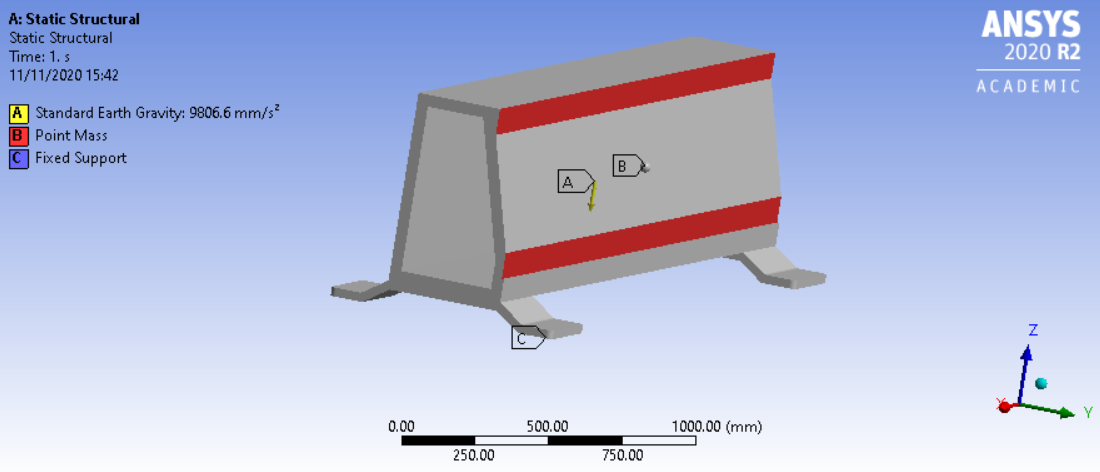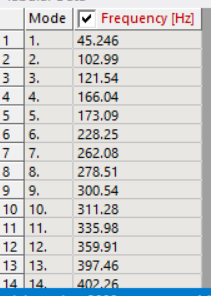TAGGED: harmonic-analysis
-
-
November 5, 2020 at 5:02 am
HarsihilZLHZ
SubscriberOn the basis of Frequency response i.e. amplitude(for example highest amplitude) Vs Frequency graph or should be equivalent stress at particular frequency ?n -
November 5, 2020 at 2:48 pm
danielshaw
Ansys EmployeeIt depends on what information you want to obtain. If you want the behavior over a frequency range, then request a frequency response. If you want the behavior a particular frequency, then request a result (e.g. equivalent stress) at a particular frequency.n -
November 5, 2020 at 3:57 pm
HarsihilZLHZ
SubscriberI was looking for frequency response but my equivalent stress is more than my yield stress. However, in Static analysis equivalent stress is less than yield stress. nSo, I was confused should I consider equivalent stress got from harmonic analysis into consideration?n -
November 5, 2020 at 10:24 pm
peteroznewman
SubscribernStatic analysis has no loads created by the dynamics of the structure.nHarmonic Response has no static loads and only shows stress for the harmonic loads and the dynamic response of the structure.nPushing with 10 lbf statically will create less stress than pushing and pulling with 10 lbf at different frequencies.nDid you do a Modal analysis to learn the first natural frequency of your structure? What was that?nIf you included the first natural frequency in the range that you analyzed in the Harmonic Response, then it is critical that you included Damping, because with no damping, the theoretical response is infinite at the natural frequency of the structure. What damping did you include? If you did not add damping, then delete your Harmonic Response results because they are wrong.n -
November 6, 2020 at 5:15 am
HarsihilZLHZ
SubscriberI have done Static analysis followed by modal and harmonic response.nYes, Peter you are right. I have not considered damping. nI saw one of your Harmonic response youtube (i.e., Bridge Harmonic response) video, in that you have applied 0.2 constant damping ratio. How did you judge that?nMaterial itself has some damping or need to provide damping such as rubber bushes?nMy system ( for reference : Figure 1 and My Model : Figure 2) does not have any damping such as rubber bushes. nI dont know, how should I suppose or calculate constant damping ratio in my harmonic analysis ?nAny suggestion would clear my concepts.nFigure 1)n nFigure 2)n
nFigure 2)n n
n
-
November 6, 2020 at 12:30 pm
peteroznewman
SubscribernThe product has a large mass at the center of the cross-beam. I expect that mass is about 29,000/9.8 = 2,957 kg. To evaluate the stress in the cross-beam, you could apply a force of 29,000 N or you could add a mass of 2,957 kg and apply a gravity load. Either method will give you similar values of stress for this statics analysis.nHowever, a Modal analysis will give two very different first natural frequencies depending on whether the cross-beam has 2,957 kg added to it or not. You didn't say what frequency you got from the modal analysis. Use Distributed Mass to add the mass to the cross-beam and rerun the modal analysis, it won't be completely accurate, because the probe tower is more concentrated in the center, but it will be a lot more accurate than having no added mass.nTo evaluate how much a structure can vibrate when a harmonic load is applied, you must have all the mass in the system, the same as you do for a modal analysis. The force that mass creates when acted on by gravity, the 29,000 N, is not a harmonic force, it is a static force and is not to be used in the harmonic response analysis. This is why the stress is exceeding yield strength. Don't use that force as a load in harmonic response, it is wrong.nLet's pretend the probe head shown in the photo has a mass (m) of 10 kg and is driven up and down with a sinusoidal motion profile. That applies a harmonic force to the structure. The force amplitude is a function of the acceleration amplitude (a) as in F = (m)(a). That is an appropriate harmonic force to apply to the structure. As you can imagine, that will only create a very small stress amplitude.nYou have to use Solution Combination to add this small harmonic stress amplitude to the large stress from the static structural analysis.nI recommend you take the free Dynamics Training Course. /courses/index.php/courses/structural-dynamics/n -
November 11, 2020 at 10:35 am
HarsihilZLHZ
SubscribernI have applied 3000 kg of point mass(see figure 1 : Named as Cover which is 3000 kg ) And done with Modal analysis.nNow I want to do Harmonic response of the structure but as per the system point mass moves Up say 500 mm and downwards say 700 mm. nHow can I simulate the point mass of 3000kg(i.e. Cover see Figure 1) in up and downward direction as a harmonic load ?. n
n n
n
-
November 12, 2020 at 12:55 am
peteroznewman
SubscribernI doubt the 3000 kg cover is moving up and down by 500 mm. That is more likely a dead weight, meaning that there is no harmonic load there.nFigure out what moves, how much the moving part weighs and the acceleration profile of the moving part.n -
November 12, 2020 at 7:37 pm
HarsihilZLHZ
SubscribernSee Figure X, I have marked in red. The Cover (marked in RED) moves up and down.nShould I do harmonic response or transient analysis?nIf transient, then I can apply displacement in upward and downward direction wrt time. Also, it is possible to apply displacement as an amplitude in Harmonic response ? nFigure X)n any suggestions please ?nThanks!n
any suggestions please ?nThanks!n
-
November 12, 2020 at 11:42 pm
peteroznewman
SubscribernIs the moving mass of the cover (tower) 3000 kg? You need to know the true mass. There is a carriage that travels horizontally. That mass is not moving vertically, so don't include that with the vertically moving mass. That can be included as a point mass on the horizontal beam.nNext you need the motion profile. That is the displacement-time graph (or velocity-time graph). You would apply that to a translation joint between the tower and the carriage.nWith those two pieces of information, you can perform a Transient Structural analysis.nI doubt the motion profile is harmonic. Why would it be?n
-
Viewing 9 reply threads
- The topic ‘In harmonic response, how to evaluate the results?’ is closed to new replies.
Ansys Innovation Space


Trending discussions


Top Contributors


-
3757
-
1333
-
1168
-
1090
-
1014
Top Rated Tags


© 2025 Copyright ANSYS, Inc. All rights reserved.
Ansys does not support the usage of unauthorized Ansys software. Please visit www.ansys.com to obtain an official distribution.







